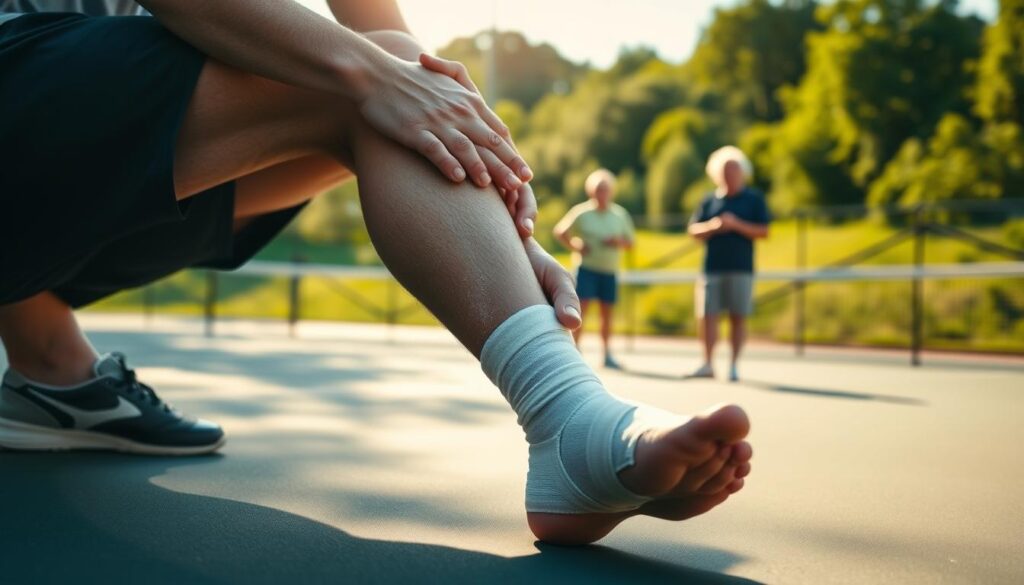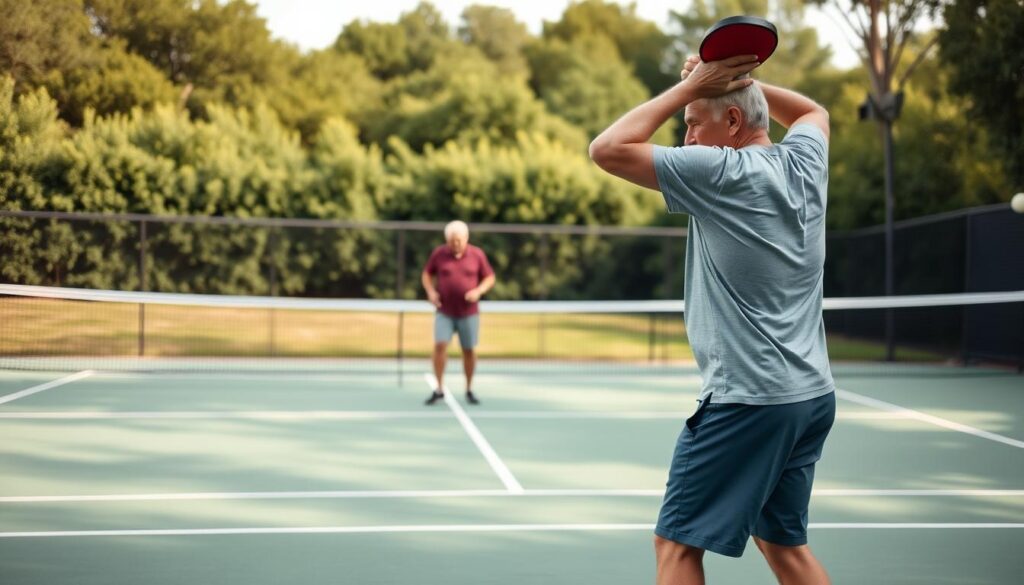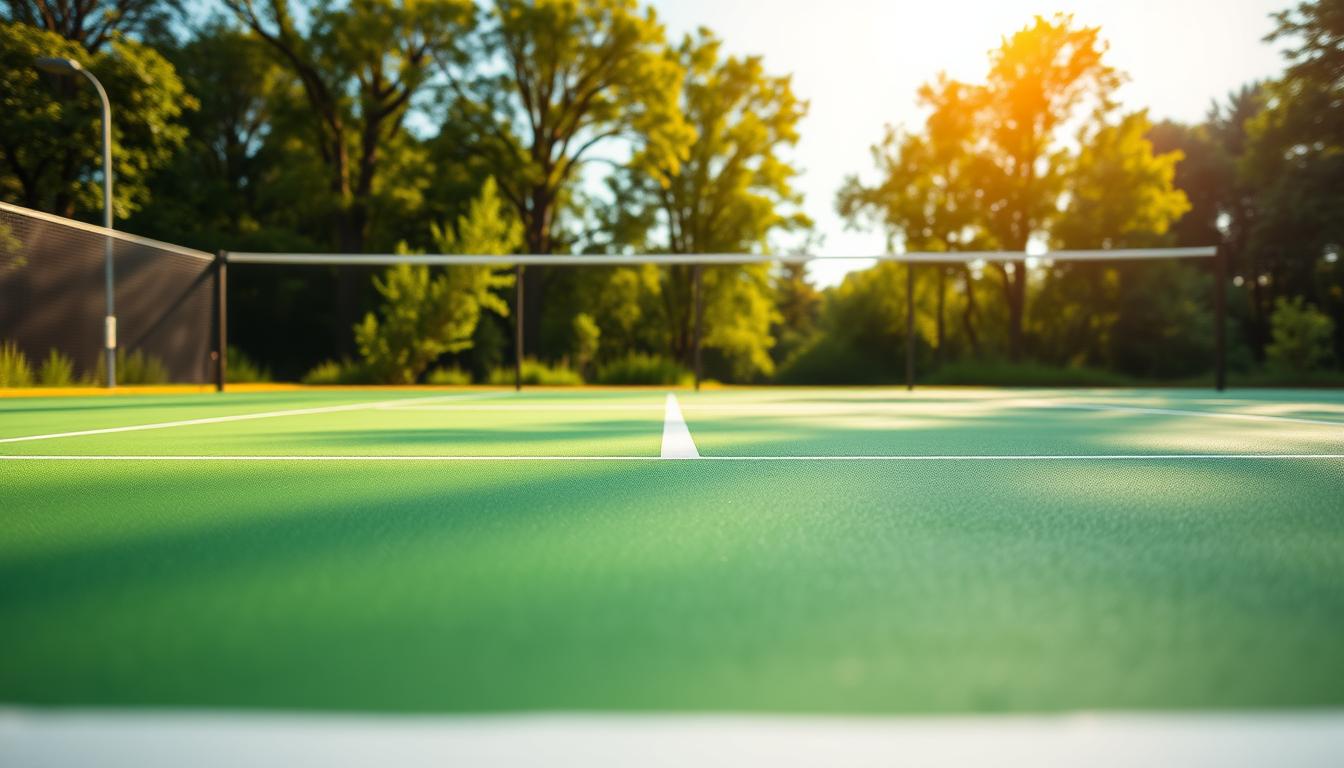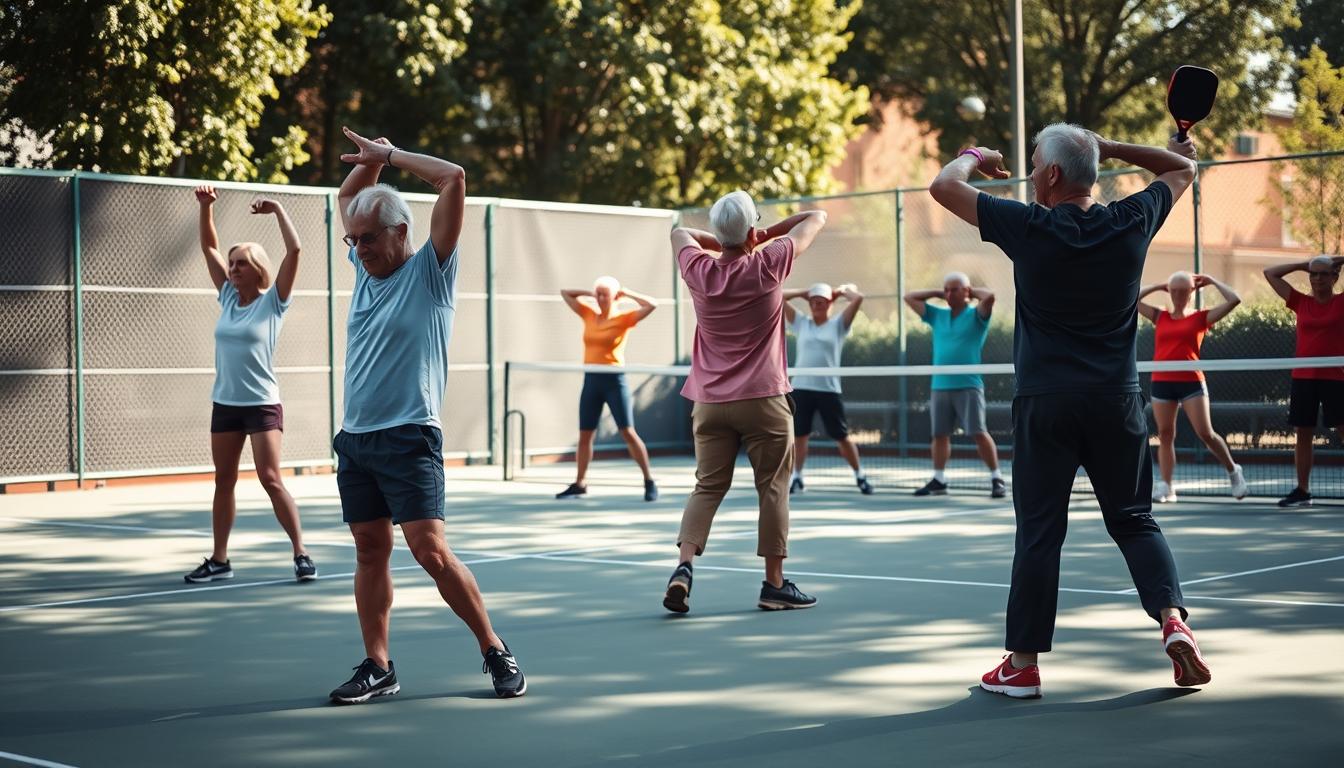Can a brief, science-backed warmup in just minutes really cut your risk of injury and boost court performance?
Pickleball participation among older adults has surged, and emergency room data from 2010–2019 show many injuries come from slips, trips, and falls that cause sprains, fractures, and contusions.
A short, gentle routine helps prepare the lower back, hips, knees, ankles, and shoulders for quick, multidirectional moves. Experts recommend moving continuously through ranges of motion and avoiding holds longer than about five seconds.
This guide shows players 50+ how to mobilize key joints and activate muscles so you step on court feeling ready rather than rushed. The sequence balances mobility and activation to support performance and lower injury likelihood.
Practical options let you use a fence or bench for balance, and pacing tips explain where seconds matter for safe range-of-motion priming. Repeatable before every session, the routine builds steady mobility without fatigue.
Why stretching matters for seniors on the pickleball court
Many injuries happen in a single misstep or quick pivot when joints and muscles are not warmed. From 2010 to 2019, emergency room records showed most older-adult pickleball injuries stemmed from slips, trips, and falls that produced sprains, fractures, and contusions. Men more often had strains; women more often had wrist fractures.

What rising pickleball injuries reveal
Slippery traction and sudden directional change raise injury risk. Arriving early and using steady ranges of motion helps prime the body and reduces that risk. Coach Robert Linkul advises avoiding static holds longer than five seconds.
Performance gains: flexibility, coordination, circulation, power
A brief warmup boosts flexibility and circulation so muscles react more smoothly. That improves coordination and lets you move with more power and less compensation.
Key body areas to prime before play
| Area | Common issue | Quick prep move | Benefit |
|---|---|---|---|
| Lower back | Stiffness, reduced rotation | Gentle trunk twists | Better tracking and rotation |
| Hips & knees | Limited lateral mobility | Side lunges, mini squats | Safer direction changes |
| Ankles & shoulders | Instability, limited range | Ankle circles, scapular glides | Fewer stumbles; cleaner overheads |
Safety first: warm up principles for older pickleball players
Warmups should feel deliberate, not rushed. Begin with slow, repeated movement through joint ranges rather than long holds. Senior fitness expert Robert Linkul recommends avoiding static positions longer than about five seconds to reduce strain and prime tissues safely.
Keep each pass brief—just a few seconds of gentle reach or roll—then return to neutral and repeat. Aim for a total routine of about 4–6 minutes of progressive motion. If breathing remains easy and joints feel good, increase range slowly.
Move gently through ranges of motion, avoid long static holds
Use continuous motion to prepare ankles, knees, hips, spine, and shoulders. Treat static stretching as a post-play tool; long holds can lower immediate power and raise injury risk before activity.
How hard and how long: seconds, minutes, and pacing before play
Use a talk-test intensity: you should be able to speak in full sentences while you move. Even two or three focused minutes are helpful when time is tight.
- Start small and slow; build only if comfortable.
- Spend extra time on past-injury areas with gentle movement.
- Balance the routine across major joints to reduce compensation.

Quick pre-court checklist to set up a safe stretching routine
Take a moment to set up before you warm up. A courtside warmup works in minimal space. Use a fence, net post, or bench for quick support and to keep movement safe.
Space, footwear, and paddle-ready posture
Scan the court for a clear, dry patch near solid support so you can move without risking slips. Wear supportive shoes that offer traction and room for your toes and foot arch.
Keep your paddle in hand or close by to cue sport posture: neutral spine, soft knees, and an athletic stance that matches how you’ll play.
Balance support: using a fence, net post, or bench
Stand side-on to a fence or post for upper-body mobility while retaining instant balance help. Use benches for seated options when balance feels fragile.
- Prioritize ankle circles, calf raises, and shoulder rolls if short on time.
- Hydrate and check glasses fit before you begin so you stay focused during drills.
- Coordinate with other players to alternate sides and avoid crowding the warmup area.
| Option | Best for | Quick benefit |
|---|---|---|
| Fence or net post | Standing mobility drills | Instant balance support during transitions |
| Bench | Seated hip/hamstring work | Safer for those with reduced balance |
| Open court patch | Dynamic footwork practice | Space for shuffles and pivots |
vegan pickleball seniors stretching: a step-by-step dynamic warmup
Start your courtside routine with focused, flowing motions that wake joints without tiring them. This short sequence takes a few minutes and uses gentle repetitions to improve mobility and muscle readiness for play.
“Avoid static holds longer than about five seconds; move continuously to prime tissues safely.”
Lower body primer: calf raises, ankle circles, and toe-to-heel rocks
Spend 1–2 minutes on lower legs. Do 10–15 calf raises, 10 ankle circles each direction, and slow toe-to-heel rocks for 20–30 seconds to wake up your feet and ankles.
Hip and knee prep: side lunges and gentle hamstring curls
Prime hips with side lunges: step out, sit back for one to two seconds, then return. Repeat 6–8 reps per side.
Add standing hamstring curls while holding a fence: curl the heel to the glute for one to two seconds, 8–10 reps per leg.
Core wake-up: trunk twists for torso rotation and lower back comfort
Stand tall, brace lightly, and rotate through the mid-back for one to two seconds per side. Do 10–12 reps to prepare torso motion for court direction changes.
Shoulder activation: shoulder rolls and sitting shoulder stretch
Roll shoulders forward and back 8–10 times, squeezing the shoulder blades on backward rolls. If needed, use a brief sitting shoulder stretch for up to five seconds and repeat 3–5 times.
Hip and lower back mobility to reduce injury risk and improve movement
Dynamic hip and spine prep mirrors the quick rotations you’ll need on court while keeping strain low.
Start standing with light support at a fence or post. Draw gentle circles with the outside leg for 8–10 reps each direction to open the hips and prepare lateral movement.
Standing hip openers for multidirectional movement
Keep the torso tall and the core engaged. These small circles increase hip mobility and cue the leg and glute muscles for side steps and diagonal cuts.
Lunge-to-rotation flow for pickleball-ready torso twists
Step into a small lunge, rotate the torso toward the front leg for one to two seconds, then return. Do 6–8 reps per side to train coordinated hip and trunk movement without long holds.
Seated or supported hamstring hinge for safer reach shots
Use a bench or place hands on your thighs. Slide the hips back, keep the lower back long, feel a gentle stretch, then stand tall for 8–10 reps. This builds leg strength and protects the lower back during reaches.
- Begin with gentle hip circles while holding support.
- Flow into lunge-to-rotation patterns to train torso twists and power transfer.
- Finish with supported hamstring hinges to keep the lower back safe and the leg drive ready for fast steps.
Shoulder and upper body stretches for paddle control and power
A focused upper-body routine primes the shoulder girdle so your paddle feels light and precise from the first rally. Keep motions brief and gentle to avoid reducing force output before serves or smashes.
Shoulder rolls, scapular glides, and gentle chest opener
Perform 8–10 shoulder rolls backward and forward. Use smooth circles that lubricate the joints and wake up the deltoids and upper-back muscles.
Add scapular glides: with elbows at your sides, slide the shoulder blades forward and back for 8–10 reps. This primes stability and improves paddle control during volleys.
Open the chest by clasping hands loosely behind you or placing hands on the fence. Lift the sternum for a few seconds without forcing the stretch to keep the torso ready for twists and overheads.
Neck rolls and posture resets to ease tension between rallies
Use slow neck rolls only within a comfortable range. Pause for a second at any tight spots to release head-and-neck tension that builds during a game.
Reset posture by stacking ears over shoulders and ribs over hips. This alignment helps transfer power from the torso to the paddle with less shoulder strain.
“If one side feels tighter, add a few extra seconds of motion there, but avoid long pre-play holds to keep upper-body power available.”
- Keep breathing steady and light to reduce excess tension across joints and muscles.
- If one side is tighter, perform an extra set of 5–10 motions on that side rather than holding a stretch long.
- These short exercises help pickleball players track balls better, reach overhead more comfortably, and recover posture quickly between points.
Feet and ankle readiness for better balance and quick direction changes
Small, intentional foot and ankle motions prepare you to absorb stops and spring into the next play.
Begin with ankle circles to restore joint motion. Do 10 circles each direction per foot. This helps you absorb sudden stops on a grippy court surface.
Follow with 12–15 calf raises, pausing lightly at the top. These build Achilles resilience for stronger push-offs and more confident lateral power.
Ankle circles and calf raises for joint mobility and Achilles care
- 10 ankle circles each way per foot to restore motion.
- 12–15 calf raises with a gentle pause for Achilles care.
Foot tripod and balance drills to steady your stance at the kitchen line
Practice a foot tripod—big toe, little toe, heel—to feel even pressure through your stance. Add a single-leg balance drill beside a fence: hover 10–20 seconds per side.
Do two-step shuffles with low hips, then reset. Hold your paddle lightly while balancing to link upper and lower body stability.
| Drill | Reps / Time | Benefit |
|---|---|---|
| Ankle circles | 10 each direction / foot | Restores joint motion for stops and starts |
| Calf raises | 12–15 reps | Preps Achilles for push-off power |
| Single-leg balance | 10–20 sec per side | Improves balance at the kitchen line |
“Finish with a relaxed stance check—knees unlocked, weight centered—to ensure readiness for any game motion.”
Cool-down and recovery: static stretching and vegan-friendly refuel tips
Finishing a match with a calm, deliberate cool-down helps muscles and joints recover faster. After activity, longer holds are appropriate to restore range and ease tightness.
Post-play holds to restore range
Shift to static stretching after your game. Hold hip flexor and hamstring positions for 20–30 seconds, 1–2 times each. These holds support flexibility and reduce next-day stiffness.
Include a gentle shoulder and chest opener for 20–30 seconds to release serving and volleying tension. Finish with a calf and feet stretch on a curb or fence base for the same time to soothe Achilles and plantar tissues.
“Even a few focused seconds of holding each stretch helps you feel looser and steadier the next day.”
Recovery basics: hydration, circulation, and light motion
Keep breathing slow and deep to support circulation; this helps clear metabolic byproducts and eases sore muscles. Between matches, walk for a few minutes instead of sitting; gentle movement preserves strength for the next game.
Hydrate with water or a low-sugar electrolyte drink. For plant-based refuel, choose bananas, dates, trail mix, or soy yogurt for carbs and potassium. For protein, eat tofu, tempeh, or a pea-protein shake within 60 minutes to aid muscle repair without heaviness.
| Action | Hold / Time | Benefit |
|---|---|---|
| Hip flexor & hamstring hold | 20–30 seconds, 1–2 times | Restores flexibility, protects lower back |
| Shoulder & chest opener | 20–30 seconds | Releases tension from serving and volleys |
| Calf & forefoot stretch | 20–30 seconds | Soothes Achilles and plantar tissues |
Quick tip: If time is short, perform each key hold once for 20–30 seconds. These brief minutes of recovery boost circulation and keep joints ready for your next court session.
Conclusion
A steady, simple warmup builds the balance, flexibility, and strength that help you enjoy playing pickleball with less risk of injury. Keep motions short and continuous to prime the hips, shoulders, feet, and leg muscles without draining power.
Spend a few minutes before each match, keep your paddle nearby, and use a fence or bench for support when needed. These exercises protect vulnerable areas and boost on-court performance so early points feel smoother.
After play, focus on recovery with hydration, protein, and gentle holds to aid muscle repair. With consistent practice you will step onto the court more confident, stable, and ready for more fun games with fellow players.




